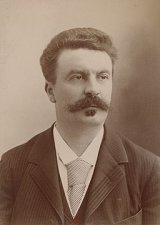The Model Page #2
"The Model" is a short story by Guy de Maupassant that explores themes of beauty, desire, and the complexities of human relationships. The narrative follows a struggling artist who becomes infatuated with a young woman he paints, ultimately revealing the tensions between artistic idealization and the realities of love and life. Maupassant delves into the nature of inspiration and the often fleeting nature of beauty, offering a poignant commentary on the sacrifices made in the pursuit of art and the emotional tumult that can ensue.
“She was silent, but at the end of a minute she felt as if she must say something and asked: “'Are you going to Paris to-morrow?' “'I do not know,' he replied. “She was annoyed again. “'Do you think it is very amusing to walk along without speaking? People talk when they are not stupid.' “He did not reply. Then, feeling with her woman's instinct that she was going to make him angry, she began to sing a popular air that had harassed our ears and our minds for two years: “'Je regardais en fair.' “He murmured: “'Please keep quiet.' “She replied angrily: “'Why do you wish me to keep quiet?' “'You spoil the landscape for us!' he said. “Then followed a scene, a hateful, idiotic scene, with unexpected reproaches, unsuitable recriminations, then tears. Nothing was left unsaid. They went back to the house. He had allowed her to talk without replying, enervated by the beauty of the scene and dumfounded by this storm of abuse. “Three months later he strove wildly to free himself from those invincible and invisible bonds with which such a friendship chains our lives. She kept him under her influence, tyrannizing over him, making his life a burden to him. They quarreled continually, vituperating and finally fighting each other. “He wanted to break with her at any cost. He sold all his canvases, borrowed money from his friends, realizing twenty thousand francs (he was not well known then), and left them for her one morning with a note of farewell. “He came and took refuge with me. “About three o'clock that afternoon there was a ring at the bell. I went to the door. A woman sprang toward me, pushed me aside, came in and went into my atelier. It was she! “He had risen when he saw her coming.' “She threw the envelope containing the banknotes at his feet with a truly noble gesture and said in a quick tone: “'There's your money. I don't want it!' “She was very pale, trembling and ready undoubtedly to commit any folly. As for him, I saw him grow pale also, pale with rage and exasperation, ready also perhaps to commit any violence. “He asked: “'What do you want?' “She replied: “'I do not choose to be treated like a common woman. You implored me to accept you. I asked you for nothing. Keep me with you!' “He stamped his foot. “'No, that's a little too much! If you think you are going—' “I had seized his arm. “'Keep still, Jean... Let me settle it.' “I went toward her and quietly, little by little, I began to reason with her, exhausting all the arguments that are used under similar circumstances. She listened to me, motionless, with a fixed gaze, obstinate and silent. “Finally, not knowing what more to say, and seeing that there would be a scene, I thought of a last resort and said: “'He loves you still, my dear, but his family want him to marry some one, and you understand—' “She gave a start and exclaimed: “'Ah! Ah! Now I understand: “And turning toward him, she said: “'You are—you are going to get married?' “He replied decidedly” 'Yes.' “She took a step forward. “'If you marry, I will kill myself! Do you hear?' “He shrugged his shoulders and replied: “'Well, then kill yourself!' “She stammered out, almost choking with her violent emotion: “'What do you say? What do you say? What do you say? Say it again!' “He repeated: “'Well, then kill yourself if you like!' “With her face almost livid, she replied: “'Do not dare me! I will throw myself from the window!' “He began to laugh, walked toward the window, opened it, and bowing with the gesture of one who desires to let some one else precede him, he said: “'This is the way. After you!' “She looked at him for a second with terrible, wild, staring eyes. Then, taking a run as if she were going to jump a hedge in the country, she rushed past me and past him, jumped over the sill and disappeared. “I shall never forget the impression made on me by that open window after I had seen that body pass through it to fall to the ground. It appeared to me in a second to be as large as the heavens and as hollow as space. And I drew back instinctively, not daring to look at it, as though I feared I might fall out myself. “Jean, dumfounded, stood motionless. “They brought the poor girl in with both legs broken. She will never walk again. “Jean, wild with remorse and also possibly touched with gratitude, made up his mind to marry her. “There you have it, old man.” It was growing dusk. The young woman felt chilly and wanted to go home, and the servant wheeled the invalid chair in the direction of the village. The painter walked beside his wife, neither of them having exchanged a word for an hour. This story appeared in Le Gaulois, December 17, 1883.
Translation
Translate and read this book in other languages:
Select another language:
- - Select -
- 简体中文 (Chinese - Simplified)
- 繁體中文 (Chinese - Traditional)
- Español (Spanish)
- Esperanto (Esperanto)
- 日本語 (Japanese)
- Português (Portuguese)
- Deutsch (German)
- العربية (Arabic)
- Français (French)
- Русский (Russian)
- ಕನ್ನಡ (Kannada)
- 한국어 (Korean)
- עברית (Hebrew)
- Gaeilge (Irish)
- Українська (Ukrainian)
- اردو (Urdu)
- Magyar (Hungarian)
- मानक हिन्दी (Hindi)
- Indonesia (Indonesian)
- Italiano (Italian)
- தமிழ் (Tamil)
- Türkçe (Turkish)
- తెలుగు (Telugu)
- ภาษาไทย (Thai)
- Tiếng Việt (Vietnamese)
- Čeština (Czech)
- Polski (Polish)
- Bahasa Indonesia (Indonesian)
- Românește (Romanian)
- Nederlands (Dutch)
- Ελληνικά (Greek)
- Latinum (Latin)
- Svenska (Swedish)
- Dansk (Danish)
- Suomi (Finnish)
- فارسی (Persian)
- ייִדיש (Yiddish)
- հայերեն (Armenian)
- Norsk (Norwegian)
- English (English)
Citation
Use the citation below to add this book to your bibliography:
Style:MLAChicagoAPA
"The Model Books." Literature.com. STANDS4 LLC, 2025. Web. 9 Mar. 2025. <https://www.literature.com/book/the_model_4092>.








Discuss this The Model book with the community:
Report Comment
We're doing our best to make sure our content is useful, accurate and safe.
If by any chance you spot an inappropriate comment while navigating through our website please use this form to let us know, and we'll take care of it shortly.
Attachment
You need to be logged in to favorite.
Log In